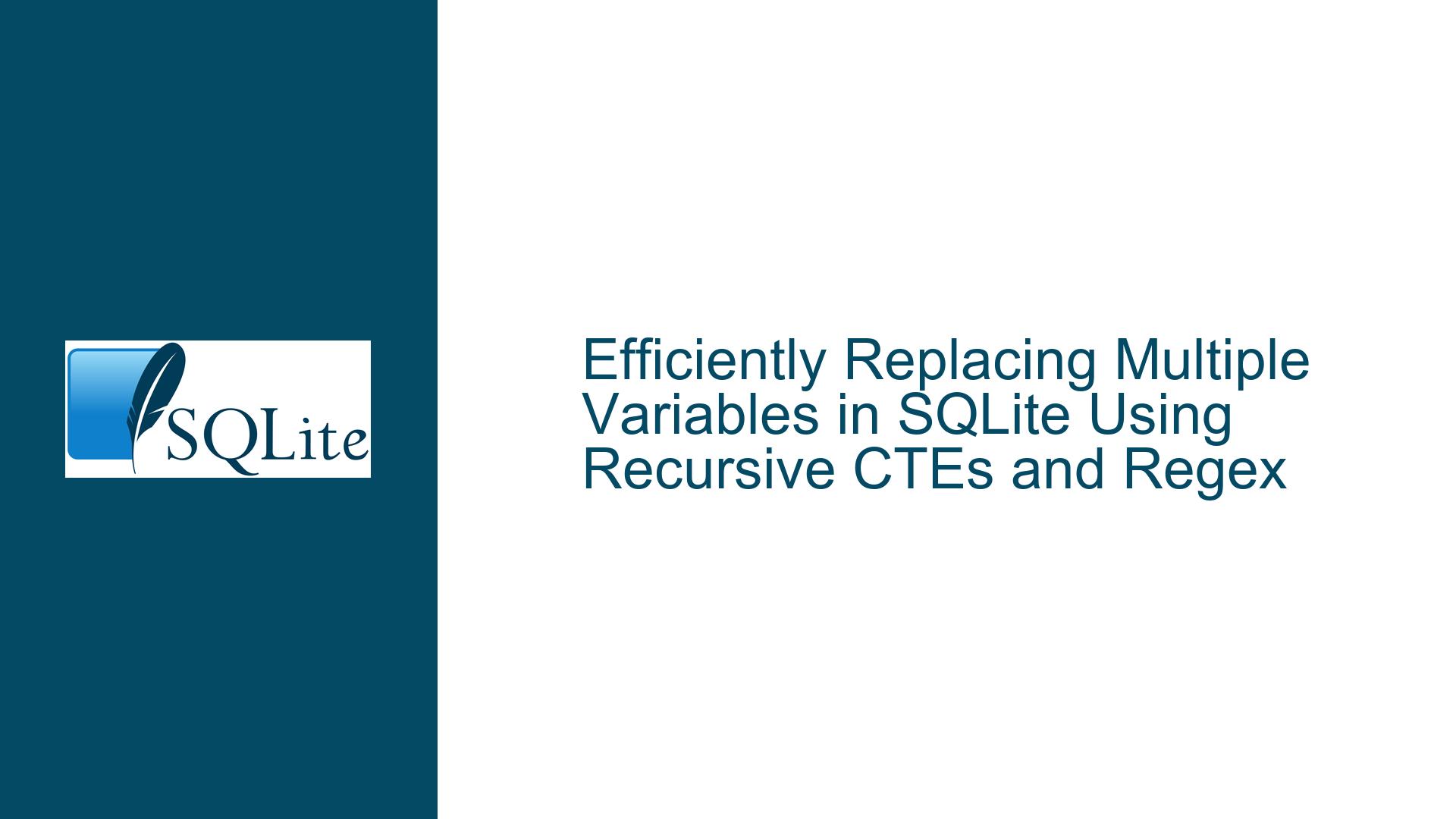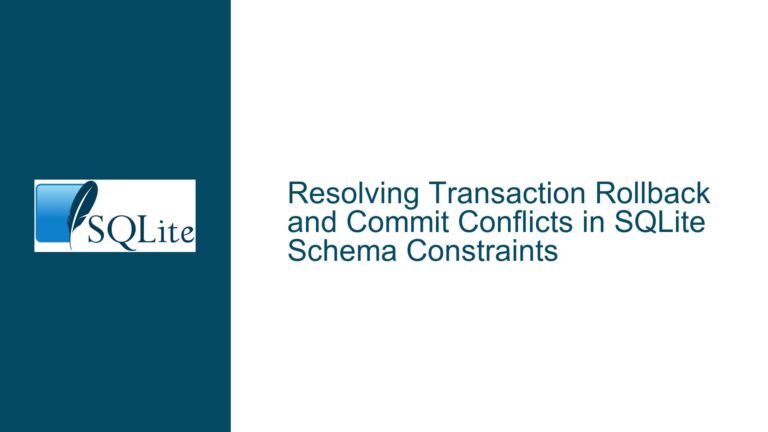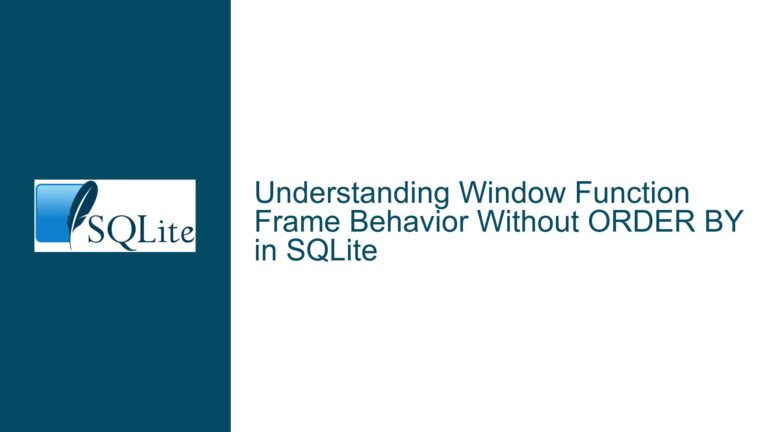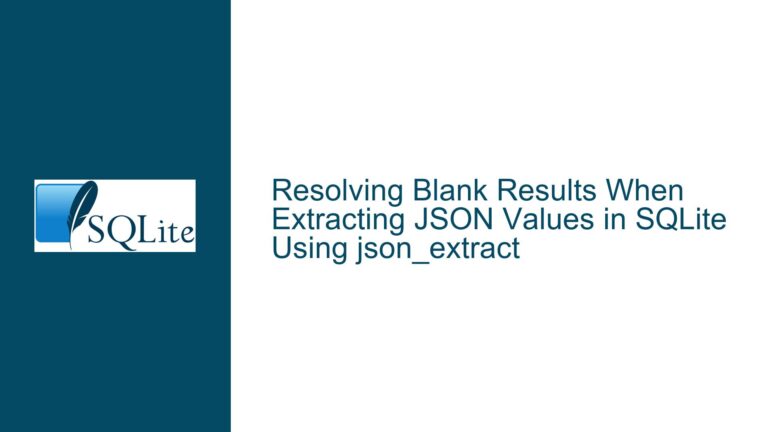Efficiently Replacing Multiple Variables in SQLite Using Recursive CTEs and Regex
Understanding the Problem: Variable Replacement in SQLite
The core issue revolves around replacing multiple placeholders in a text field (source_text) of the extention_files_detal table with corresponding values from the variable_list table. The placeholders are stored in the variable_name column of the variable_list table, and their corresponding replacement values are stored in the variable_text column. The goal is to dynamically replace all occurrences of variable_name in source_text with variable_text for each row in the extention_files_detal table.
The challenge lies in the fact that the source_text field contains multiple placeholders (e.g., {AUTHOR_EMAIL}, {DATE}, etc.), and each placeholder must be replaced with its corresponding value from the variable_list table. The user attempted to solve this problem using a recursive Common Table Expression (CTE) combined with regular expressions but encountered issues with the implementation.
Why the Current Approach Fails: Misalignment Between Regex and SQLite’s Update Mechanism
The user’s initial approach involves a recursive CTE (vl_list) that joins the variable_list and extention_files_detal tables based on a regex match (regexp_like). The CTE is then used in an UPDATE statement to replace the placeholders in source_text using regexp_replace. However, this approach fails for several reasons:
Regex Matching Limitations: The
regexp_likefunction checks if a pattern exists in a string but does not handle multiple replacements in a single pass. Each placeholder requires a separate replacement operation, which the current query does not account for.CTE Misuse in Updates: The recursive CTE (
vl_list) is designed to generate a list of replacements, but theUPDATEstatement does not iterate over this list effectively. Theregexp_replacefunction is applied to the entiresource_textfield without ensuring that all placeholders are processed.Lack of Iterative Replacement: The query does not account for the need to iteratively replace each placeholder in
source_text. Instead, it attempts to perform all replacements in a single step, which is not feasible given SQLite’s limitations.Incorrect Use of
FROMClause inUPDATE: TheUPDATEstatement uses aFROMclause to join the CTE, but this does not guarantee that each placeholder is replaced sequentially. SQLite does not support row-by-row processing in this context, leading to incomplete or incorrect replacements.
Step-by-Step Solution: Iterative Replacement Using Recursive CTEs and Regex
To solve this problem, we need to break it down into manageable steps. The solution involves using a recursive CTE to iteratively replace each placeholder in the source_text field. Here’s how to achieve this:
Step 1: Create a Recursive CTE for Placeholder Replacement
The first step is to create a recursive CTE that processes each placeholder in the source_text field. This CTE will:
- Identify all placeholders in
source_textthat match entries in thevariable_listtable. - Replace each placeholder with its corresponding
variable_textvalue. - Iterate until all placeholders are replaced.
WITH RECURSIVE replacement_cte AS (
-- Base case: Start with the original source_text
SELECT
id,
source_text AS current_text,
0 AS replacement_count
FROM extention_files_detal
UNION ALL
-- Recursive case: Replace one placeholder at a time
SELECT
efd.id,
regexp_replace(
r.current_text,
vl.variable_name,
vl.variable_text
) AS current_text,
r.replacement_count + 1
FROM replacement_cte r
JOIN extention_files_detal efd ON r.id = efd.id
JOIN variable_list vl ON regexp_like(r.current_text, vl.variable_name) = 1
WHERE r.replacement_count < (SELECT COUNT(*) FROM variable_list)
)
Step 2: Apply the Final Replacement to the extention_files_detal Table
Once the recursive CTE has processed all replacements, we need to update the extention_files_detal table with the final source_text values. This involves selecting the most recent version of current_text for each row in the extention_files_detal table.
UPDATE extention_files_detal
SET source_text = (
SELECT current_text
FROM replacement_cte r
WHERE r.id = extention_files_detal.id
ORDER BY replacement_count DESC
LIMIT 1
);
Step 3: Verify the Results
After executing the update, it’s essential to verify that all placeholders have been replaced correctly. This can be done by querying the extention_files_detal table and checking the source_text field for any remaining placeholders.
SELECT id, source_text
FROM extention_files_detal
WHERE source_text LIKE '%{%}%';
If the query returns no rows, all placeholders have been successfully replaced. If any rows are returned, further investigation is needed to identify why the replacements were incomplete.
Key Considerations and Best Practices
Performance Optimization: Recursive CTEs can be resource-intensive, especially with large datasets. To optimize performance, consider limiting the number of replacements per iteration or batching the updates.
Handling Edge Cases: Ensure that the regex patterns used in
regexp_likeandregexp_replaceaccount for edge cases, such as nested placeholders or placeholders with special characters.Testing and Validation: Before applying the solution to production data, test it on a subset of the data to ensure correctness. Use tools like SQLite’s
EXPLAINcommand to analyze query performance.Alternative Approaches: If recursive CTEs prove too slow or complex, consider using a procedural approach with a scripting language (e.g., Python) to handle the replacements outside of SQLite.
By following these steps and considerations, you can efficiently replace multiple placeholders in SQLite using recursive CTEs and regex functions. This approach ensures that all placeholders are processed iteratively and that the final source_text values are correctly updated.






